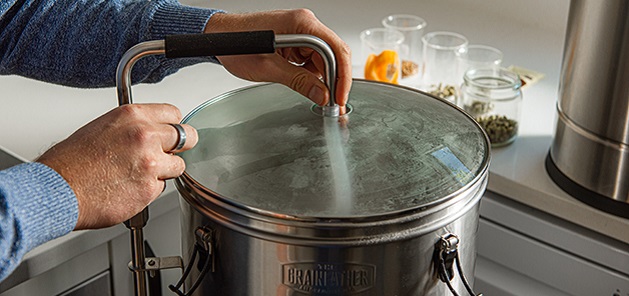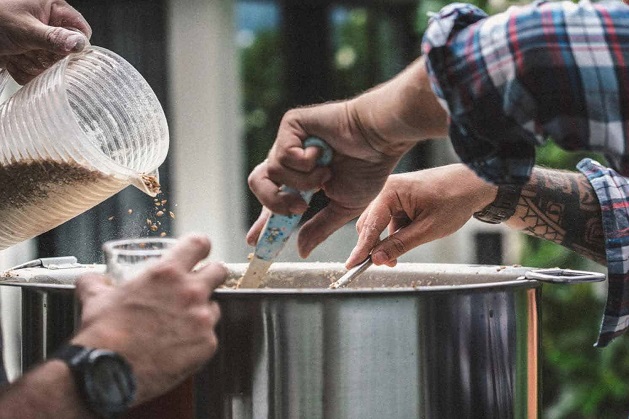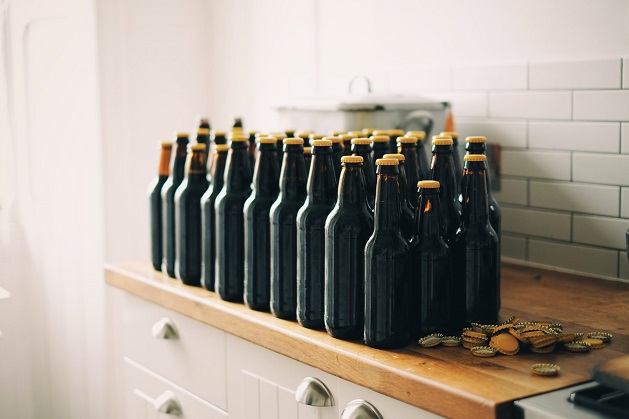Homebrewing is a fun and rewarding hobby embraced by beer enthusiasts worldwide. Each bottle of beer is a statement of the meticulous process of beer crafting that involves much creativity, patience, and the pure satisfaction of perfecting the fruits of one’s labour. If you are a true beer lover you are probably inquisitive about the process of crafting your own beer at home.
The joy of making something from scratch coupled with the eager anticipation of tasting the final product rewards you with a profound sense of fulfilment. Whether you are a complete novice or an experienced beer maker, you may benefit from deepening your knowledge as we unveil the intricacies of the brewing process.
Starting from the initial stage of selecting the right equipment, and continuing by choosing the proper ingredients for your recipe, you will embark on an adventure to create your desired flavour while gaining valuable insight into the science of beer making. Join us, as we dive into the journey from boil to bottle as we go step by step into the process of crafting delightful tastes within the comfort of your home.
Choose the Right Equipment

Selecting the perfect beer equipment for making beer at home is a crucial factor that plays a vital role in the successful beer-making process. Various factors influence your purchase, such as your budget, your experience level and the type of beer you plan to produce.
Therefore you need to get yourself educated with the thorough process of beer crafting and learn about many brands on the market to find a design that suits your needs. This involves considering factors such as finding the perfect kit, selecting a quality material for your fermenter and brew kettle, finding the perfect size that accommodates your batch, ensuring the presence of the right thermometer, and contemplating automation options.
Although brewing equipment preferences can vary among homebrewers, there is one specific brand that has managed to gain widespread popularity – the Grainfather Connect. This particular home brewing equipment features an all-in-one design, complete automation, and sleek and innovative features that make it a perfect companion for both new and experienced beer makers. Many beer enthusiasts embrace the art of homebrewing by choosing the tried and tested Grainfather Australia system due to its reliability and advanced features for crafting exceptional beers with ease.
This homebrewing equipment is designed to simplify your beer-making thanks to its automation capabilities. It allows you to do the tasks of brewing, mashing and temperature control automatically which is particularly beneficial for beginners. The connectivity feature makes it easy to control and monitor the brewing process remotely. You simply need to download the app and enjoy following the whole brewing experience.
Grainfather utilizes an electric heating system to manage the temperature during the process of mashing and boiling. It also features a built-in recirculation pump, which helps to maintain a consistent temperature throughout the brewing process. This equipment comes in various sizes that can accommodate a wide range of batch sizes. Its sleek and modern design is ensured by the construction of high-quality materials such as stainless steel that ensures its durability and the maintenance of hygiene standards throughout the brewing process.
The Grainfather Australia stores offer a wide range of homebrewing designs with similar features allowing users to find the model that suits their production needs. This brand often comes with accessories such as a fermenter, sparge water heater, and cleaning equipment essential for the brewing process. Many homebrewers Australia-wide prefer this brand as it offers exceptional features that contribute to the production of quality beer.
Select Your Recipe
As homebrewing gained popularity many homebrewers started to explore the art of blending diverse ingredients while incorporating innovative methods, resulting in a diverse array of flavours that transcend traditional brewing practices – beyond Octoberfest. However, different beer recipes differ in the flavours and styles they offer as each requires different levels of skills and practice. Therefore it’s of crucial importance to choose a recipe that not only aligns with your taste preference but also matches your experience.
Homebrewers have the flexibility to make a wide range of beers ranging from traditional ones such as Pilsner, a classic Irish stout, and Vienna lager to combining innovative techniques and unique ingredients in making some not-so-common tastes. For instance, milkshake IPAs include lactose in the recipe for a more creamy flavour coupled with notes of vanilla for additional sweetness.
Also, you may decide to mix two traditional recipes to create a hybrid flavour. Beginner brewers are advised to start with some simpler recipes before engaging in more complex brewing endeavours. As certain beer recipes may require the usage of more advanced equipment, you should be mindful when selecting a recipe, as finding one that matches your skill level, taste and brewing goals is of vital importance in your homebrewing journey.
Start the Brewing Process

Now that you’ve chosen your favourite recipe you can get yourself prepared to start the brewing process. First of all, you need to make sure that all your equipment is completely sanitized to avoid contamination. Once sanitation is complete, you can heat up the water in the brewing kettle to 65-71°C and add the mixture of your ingredients inside.
After this comes the lautering procedure that involves draining the liquid (wort) from the mashed grains. As the water starts to boil you can add hops and certain spices to achieve the desired bitterness and aroma. The process of boiling often lasts from 60 to 90 minutes and this often influences the overall beer colour, bitterness level and flavour.
Cooling, Fermentation and Maturation
Once you are finished with the process of boiling you can start with the cooling procedure. Rapid cooling is essential for the fermentation process that follows, so you need to cool the wort to a temperature suitable for the process which is typically 65-75°F or 18-24°C. After the cooling stage, the wort is transferred into a sanitiser fermenter where yeast is introduced to initiate the process of fermentation.
During this process, you need to seal the fermenter with an airlock to allow the carbon dioxide to escape and prevent other contaminants from entering. After this, you should let your beer mature until it develops the desired flavour. This process of maturation lasts around two weeks, and it can be monitored through a hydrometer to make sure that the entire process of fermentation is complete.
Bottling

Lastly, the final stage of the whole process of crafting your perfectly flavoured beer is the process of bottling. The bottling is a crucial step that involves packing your finished product for consumption. After the maturation process, the beer is siphoned into sanitized bottles or kegs, and a desired amount of sugar is added to stimulate the process of natural carbonation.
Subsequently, the bottles are sealed with caps and stored in cool, dark places for several weeks to aid the process of carbonation which contributes to achieving the desired levels of fizziness. Once this process is over, you are ready to savour the result of your effort and share your favourite drink with friends, celebrating the culmination of your homebrewing journey.


